
Ice Baths: A Key to Enhanced Recovery and Vitality for Athletes
Explore how ice baths can boost recovery and enhance vitality for athletes. Discover practical tips and insights to elevate your performance. Read more!
Spend Over £500 To Get Free UK Delivery - Excludes Certain Postcodes & Round Ice Baths

When you flirt with the cold, you do more than tough it out, you manipulate physiology. Immersion at 10–15°C for 10–15 minutes can blunt inflammatory signalling, limit secondary muscle damage, and curb DOMS by constricting vessels, reducing oedema, then accelerating nutrient influx on rewarming. You also temper peripheral nerve conduction and preserve metabolic energy stores. Yet timing, dose, and context matter, especially if you’re chasing hypertrophy or peak power. Here’s where precision turns cold water into a tool, not a guess.
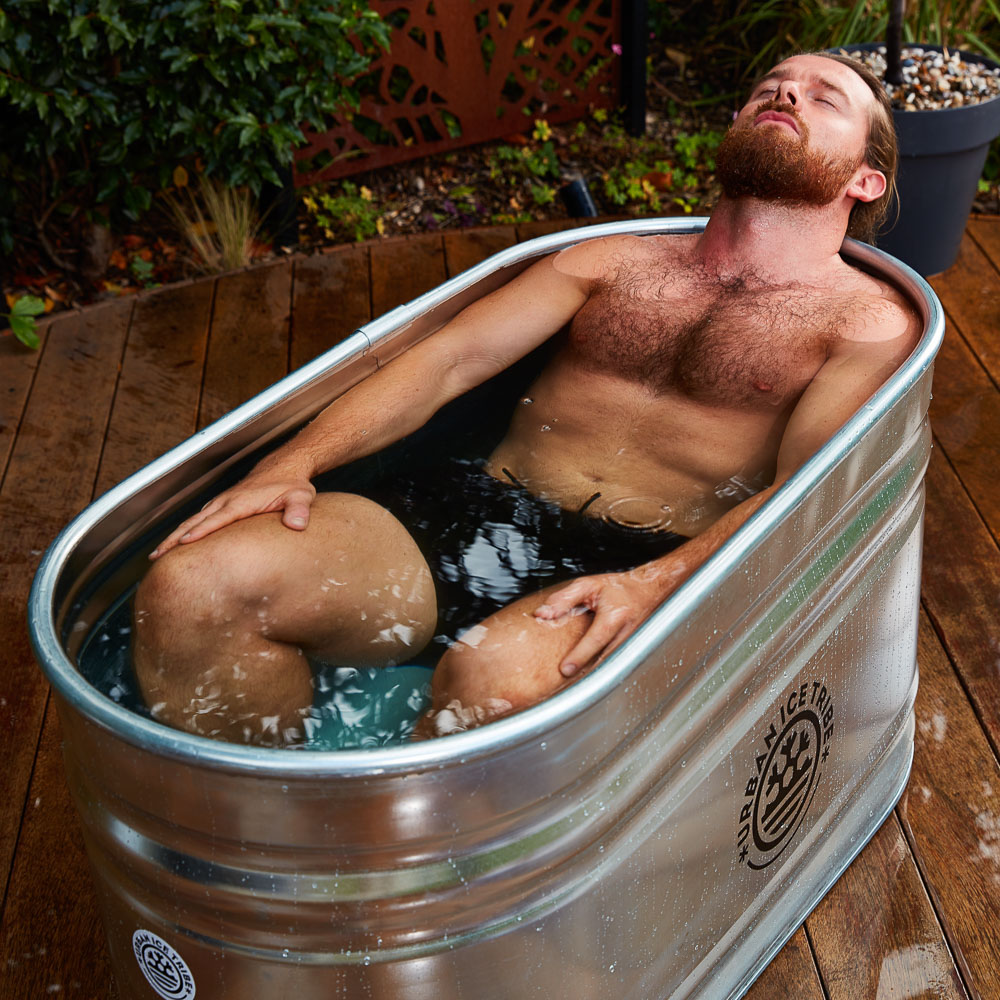
Although cold therapy spans several methods, the core principle is consistent: brief cold exposure lowers tissue temperature to blunt inflammation, slow nerve conduction, and attenuate secondary muscle damage after intense exercise.
You’ll use it to rapidly reduce local metabolic demand, limiting ischemia-reperfusion injury and oedema formation. Vasoconstriction decreases capillary permeability, curbing fluid shift, while reduced nociceptor firing decreases pain perception and reflex spasm.
For muscle recovery, timing and dose matter: apply cold therapy within 30–60 minutes post-session for 5–15 minutes per region, maintaining skin temperature near 10–15°C. Combine with gentle compression to optimise hydrostatic effects.
Avoid prolonged exposure that might suppress anabolic signalling. Screen for contraindications (Raynaud’s, peripheral neuropathy, poor circulation). Integrate hydration and protein intake to support perfusion and tissue remodelling.

When you immerse post-exercise muscle in 10–15°C water, rapid vasoconstriction lowers intramuscular temperature, suppressing inflammatory mediator release (e.g., prostaglandins, cytokines) and limiting neutrophil/macrophage infiltration that drives secondary myofibrillar damage.
This blunts oedema, reduces nociceptor sensitisation, and preserves sarcolemmal integrity. Ice baths also decrease metabolic rate and reactive oxygen species generation, conserving ATP for ion pump function and accelerating restoration of calcium homeostasis—key for sarcomere repair.
Cold-induced hydrostatic pressure aids venous and lymphatic return, clearing metabolites and proteolytic byproducts that impede regeneration.
Post-immersion reactive hyperemia enhances nutrient and amino acid delivery during rewarming, supporting protein synthesis.
Together, these mechanisms shorten repair timelines and mitigate delayed onset muscle soreness without masking true injury, letting you resume high-quality training while maintaining tissue integrity.

Even after a well-planned session, you can develop delayed onset muscle soreness (DOMS) 12–24 hours post-exercise, peaking around 24–72 hours due to microstructural damage from unaccustomed or eccentric loading.
You’ll feel muscle soreness as myofibrillar disruptions trigger localised inflammation, calcium dysregulation, and nociceptor sensitisation. Sarcomere overstretch and Z-line streaming impair force transmission, while reactive oxygen species and prostaglandins amplify pain signalling.
Swelling increases intramuscular pressure, further activating group III/IV afferents and stiffness.
You can moderate severity by managing training novelty, emphasising progressive eccentric exposure, and ensuring adequate sleep and hydration.
Hydration supports perfusion, metabolic clearance, and ideal fascial gliding; electrolyte balance aids excitation–contraction coupling.
Protein (leucine-rich) and carbohydrate timing support repair and glycogen restoration.
Gentle mobility and low-intensity circulation work facilitate recovery without compounding tissue stress.
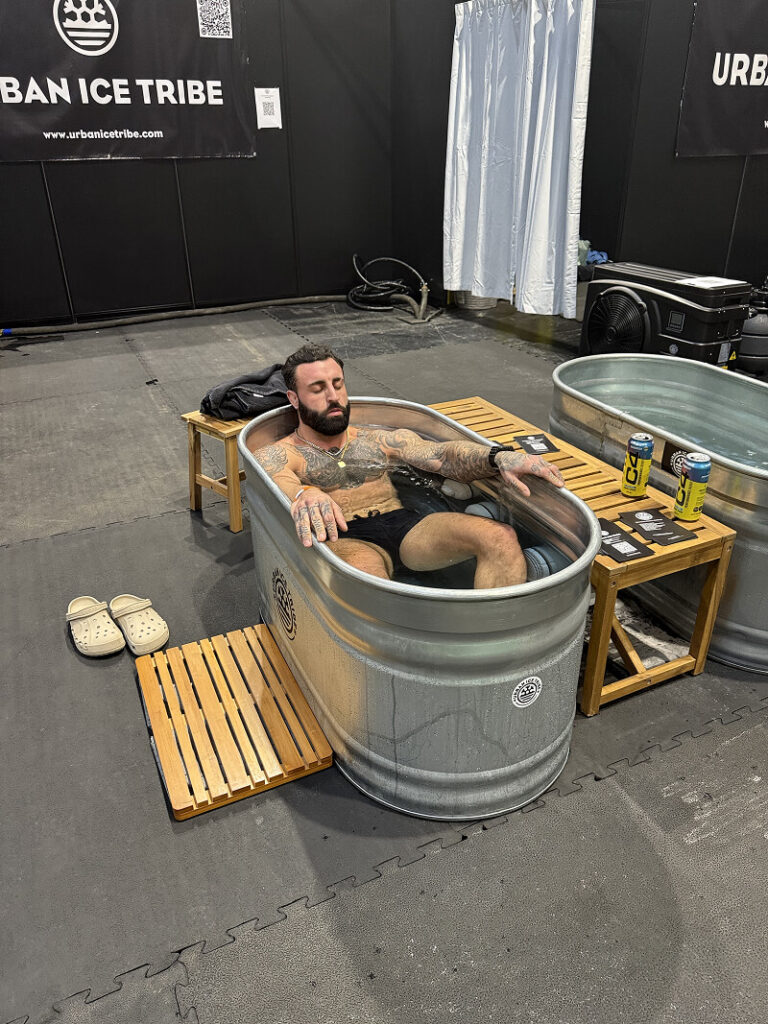
Because acute inflammation can impede force recovery and amplify DOMS, cold exposure targets upstream mediators to blunt the response without halting repair. You leverage vasoconstriction and reduced tissue temperature to slow enzymatic activity, curb neutrophil infiltration, and downshift cytokines like IL-6 and TNF-α.
Short, post-exercise immersion (10–12 minutes, 10–15°C) tempers oedema and nociceptor signalling, preserving torque while allowing myofibrillar remodelling to proceed.
Monitor skin temperature, immersion dose, and soreness to individualise response.
Although cold constricts peripheral vessels, you exploit a potent “contrast” effect: immersion acutely reduces skin and superficial muscle blood flow, then drives a rebound hyperemia on rewarming that accelerates metabolite clearance and restores oxygen delivery.
This improves circulation dynamics, stabilises endothelial function, and may enhance capillary recruitment. Cold also activates sympathetic outflow, increasing norepinephrine and heart rate variability indices linked to autonomic balance.
You’ll dampen peripheral nerve conduction velocity, reducing pain signalling while preserving motor control. Baroreflex engagement during immersion can normalise vascular tone and support central blood volume.
Maintain hydration to sustain plasma volume, optimise stroke volume, and prevent viscosity-related flow limitations. Short bouts (5–10 minutes, 10–15°C) post-exercise appear sufficient to induce these effects without compromising tissue perfusion.
Why time hydration so carefully around cold water therapy? Cold immersion induces diuresis via cold-triggered vasoconstriction and reduced ADH, increasing urine output and risking underhydration post-bath.
You’ll also shiver, elevating metabolic demand and fluid loss via respiration. To stay hydrated, plan fluid intake before and after to maintain plasma volume, perfusion, and thermoregulatory stability without over-dilution.
This timing preserves circulatory stability, supports recovery, and helps you stay hydrated efficiently.
When cold immersion ramps up diuresis and shifts fluid from the periphery to the core, you lose sodium-rich fluid and dilute plasma electrolytes, so timing and composition of drinks matter.
Prioritise sodium to sustain plasma volume, thirst, and aldosterone-driven reabsorption. Pre-immersion, take a modest sodium load (e.g., a low-sugar electrolyte drink) to blunt natriuresis.
Immediately post-immersion, target rehydration with 1.2–1.5 L per kilogram of body mass lost, using a solution containing 500–700 mg sodium per litre; add potassium (~200 mg/L) to aid intracellular restoration and muscle excitability.
Choose low-osmolality formulas to accelerate gastric emptying and intestinal absorption via sodium-glucose cotransport. If you’re cramp-prone or a salty sweater, increase sodium toward the higher range.
Avoid hypertonic, sugary drinks that slow rehydration.

Protocols anchor cold exposure to specific outcomes. You’ll match ice bath dose to your goal by controlling water temperature, immersion time, and weekly frequency. Aim for 10–15°C to induce vasoconstriction, reduce inflammatory signalling, and blunt nociceptor activity without excessive cold stress. Start with 6–8 minutes, progress to 10–12 minutes as tolerated. Maintain hydration to stabilise plasma volume and support thermoregulation; cold diuresis can mask fluid loss.
Track skin temp, shiver onset, and recovery markers to refine dose.
Although recovery is the primary target, cold exposure can also shape performance by modulating neuromuscular and autonomic systems. Brief immersions increase sympathetic outflow and catecholamines, sharpening arousal and motor unit recruitment.
Cold-induced vasoconstriction followed by reactive hyperemia may improve muscle oxygenation kinetics in subsequent efforts. You’ll likely perceive less exertion due to reduced nociceptor signalling, enabling higher training quality without masking injury.
Repeated bouts drive resilience adaptations: enhanced vagal tone at rest, faster heart rate recovery, and improved cold shock tolerance, all supporting performance under stress.
Mitochondrial biogenesis markers can rise with intermittent cold, potentially improving oxidative capacity. Maintain hydration to offset cold diuresis and preserve plasma volume; pair fluids with electrolytes to stabilise cardiac output and thermoregulation.
Integrate strategically around high-intensity sessions, not replacing foundational training.
Performance gains don’t negate risk management. Prioritise safety considerations before you submerge. Cold induces peripheral vasoconstriction, elevates afterload, and can trigger arrhythmias in susceptible hearts.
If you’ve got cardiovascular disease, uncontrolled hypertension, Raynaud’s, neuropathy, or open wounds, skip ice baths. Monitor hydration levels; hypohydration thickens blood, raising cardiac strain and frostnip risk. Limit immersion to 10–15 minutes at 10–15°C, keep the chest out initially, and rewarm gradually to prevent afterdrop.
Always have supervision, a timer, and a warm environment ready.
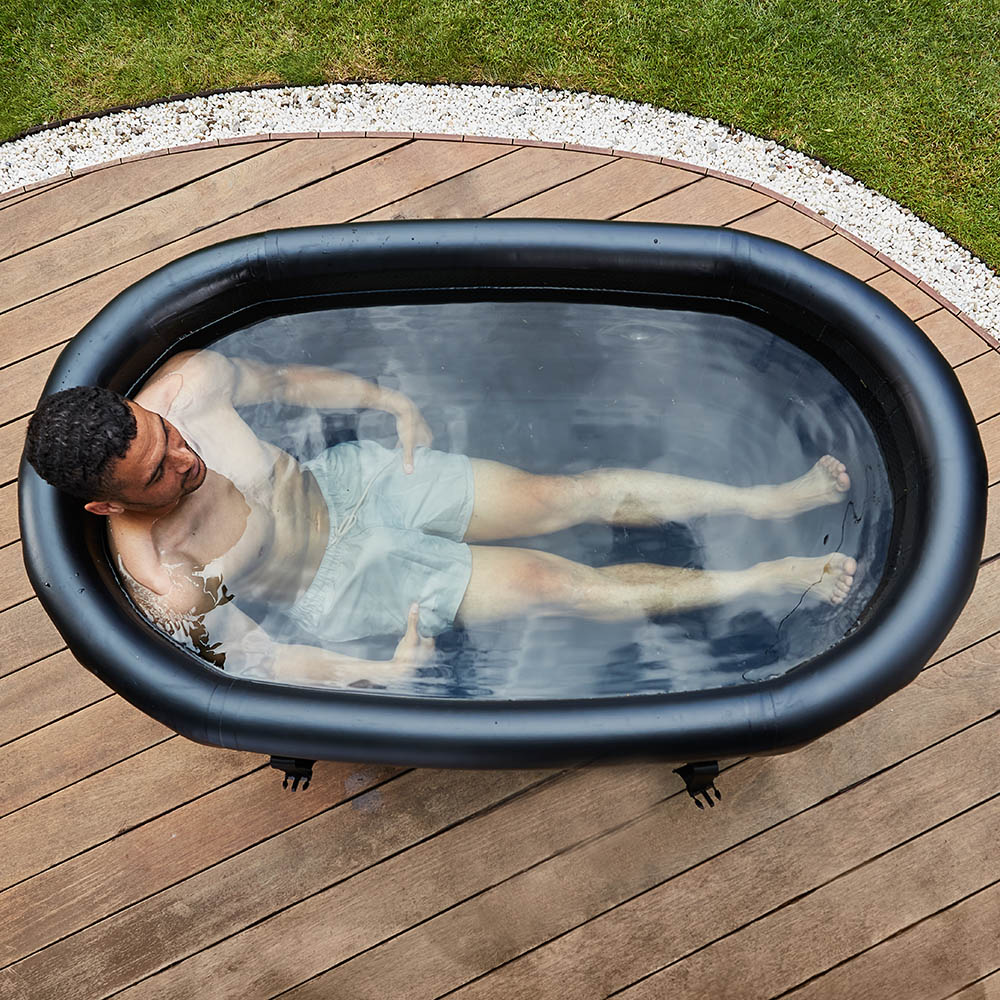
When you align cold exposure with training and nutrition, you can amplify recovery without blunting adaptations. Use cold water therapy strategically: after skill or endurance sessions to reduce oedema and nociceptor signalling, but delay it 6–8 hours post-heavy strength work to preserve mTOR and satellite-cell activity.
Target 10–12 minutes total at 10–15°C, split into 2–3 bouts, to downshift sympathetic drive and accelerate parasympathetic rebound.
Pair fueling with timing. In the first hour post-exercise, prioritise 0.3 g/kg protein and 1.0–1.2 g/kg carbohydrate; cold reduces gastric emptying, so use warm fluids and easily digested carbs around immersion.
Guard hydration: replace 125–150% of body mass lost, include 500–700 mg sodium/L, and monitor urine colour.
Add omega-3s and polyphenols to modulate inflammatory signalling without excessive suppression.
Because recovery status dictates how you dose cold exposure and training load, track objective and subjective markers daily and respond to deviations.
Use a repeatable recovery routine with morning baselines and post-session checks. Prioritise consistency over volume; adjust ice-bath duration/temperature when strain rises or readiness drops.
Quantify sleep (duration/efficiency), mood, and soreness. Align cold exposure after high-damage days; avoid immediately post-strength when hypertrophy is prioritised.
Reassess weekly, progressing only when metrics stabilise.
Yes. Coincidentally, evening ice baths can lower core temperature, promote melatonin onset, and dampen sympathetic tone, improving sleep latency and depth. Time them 1–2 hours before bed; avoid immediately post-training if hypertrophy is a goal due to blunted anabolic signalling.
Cold plunges can enhance mental health and stress resilience by activating catecholamines, dampening amygdala reactivity, and boosting vagal tone. You’ll feel improved mood, alertness, and stress tolerance. Start brief, 10–60 seconds, progress cautiously, avoid with cardiovascular instability, Raynaud’s, or pregnancy.
You need a sturdy tub, thermometer (10–15°C), ice source, timer, non-slip mat, warm clothing, hydration, and supervision. Add GFCI-protected outlet for chillers, water sanitiser/filters, circulation pump, gradual entry/exit steps, and a pulse oximeter for monitoring adverse responses.
Yes. You increase water and energy consumption, CO2 from ice production, and microplastic shedding from bags. You mitigate impact by using recirculating chillers, insulated tubs, tap-cold only, closed-lid sessions, salt-ice reuse, and rainwater capture, while disinfecting with minimal chemicals.
You draw on Nordic sauna-plunge contrasts and Japanese misogi rituals: heat-cold cycles induce vasoconstriction-dilation, catecholamine release, brown fat activation, and reduced inflammation. Ancient exposure toughened resilience; modern protocols quantify durations, temperatures, and rewarming, optimising DOMS mitigation, autonomic balance, and mitochondrial biogenesis.
You’re not chasing toughness; you’re engineering recovery. Treat cold water like a pit stop: 10–15 minutes at 10–15°C trims inflammatory “drag,” constrains microvascular leakage, and blunts nociceptor firing, so you preserve ATP for repair. In one rugby study, post-match cold immersion reduced 24–48h soreness and CK levels, accelerating repeat-effort readiness. Rewarm to drive reactive hyperemia and nutrient flux. Screen for contraindications, stack with protein and sleep, and track HRV and soreness. Precision beats bravado—consistently.

Founder of Urban Ice Tribe

Explore how ice baths can boost recovery and enhance vitality for athletes. Discover practical tips and insights to elevate your performance. Read more!
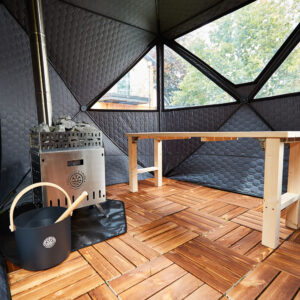
There’s nothing quite like the raw, elemental power of a pop-up sauna. Portable, authentic, and deeply restorative, it’s the perfect way to reconnect with nature and yourself. But to take your sauna ritual to the next level, the right sauna accessories can make all the difference.
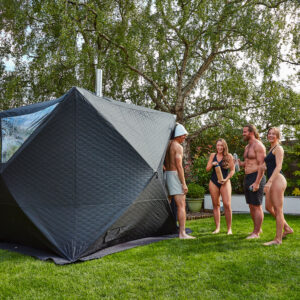
Transform your outdoor space into a personal wellness retreat with the Urban Ice Tribe Sauna Tent. This detailed setup guide walks you through every step, from unboxing to your first steam session, blending practical instruction with the mindful ritual of heat therapy.
Helping men & women release anxieties & limiting beliefs to experience a life of freedom using powerful breathwork, cold water therapy, movement & sound healing.


No spam, notifications only about new products, updates, offers and announcements.